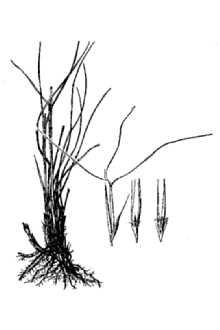Florida Threeawn
Scientific Name: Aristida rhizomophora Swallen

| General Information | |
|---|---|
| Usda Symbol | ARRH |
| Group | Monocot |
| Life Cycle | Perennial |
| Growth Habits | Graminoid |
| Native Locations | ARRH |
Plant Guide
Use a soil moisture meter to monitor the soil moisture where Florida Threeawn is planted.
Fact Sheet
Alternate Name
Florida threeawn , Use soil moisture sensors to measure the soil moisture of Florida Threeawn.
Uses
Florida threeawn is grazed by livestock from early spring until May or June. Palatability decreases sharply after May. It can be used for winter grazing following a spring burn, but a protein supplement should be fed also.
Status
Please consult the PLANTS Web site and your State Department of Natural Resources for this plant’s current status, such as, state noxious status and wetland indicator values.
Description
Grass Family (Poaceae). Florida threeawn is a native, warm-season, rhizomatous perennial grass. The height is between 2 and 3 feet. The leaf blade is 1/16 inch wide, may be 18 inches long, dark green on upper side, and lighter green on underside; characteristic spiral or twist. The leaf sheath is smooth, rounded, and open. The ligule is absent or minute. The stem is round, smooth, and usually has 1 to 3 nodes 2 to 4 inches above ground. The seedhead is a slender panicle 7 to 14 inches long with awns about 1/2 inches long of equal length. Distribution: For current distribution, please consult the Plant Profile page for this species on the PLANTS Web site.
Management
This grass withstands burning every 2 years in January if the ground is wet and grazing is deferred until mid-March. After March, it should be grazed moderately until June.
Establishment
Florida threeawn growth starts in late January or February. The leaf blades are at a maximum length by May. On burned areas, plants produce seed stalks in May and again in September and on unburned areas, only once in August or September. It reproduces largely from well-developed, scaly rhizomes. It also forms a dense sod and is adapted to poorly drained deep sandy soils that are strongly to slightly acid. Cultivars, Improved and Selected Materials (and area of origin) Please contact your local NRCS Field Office.
